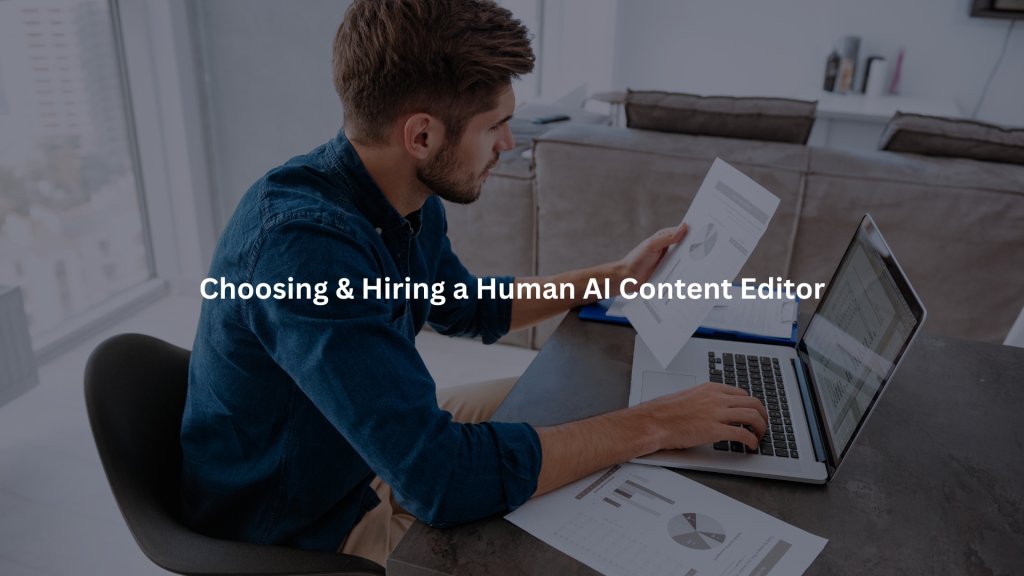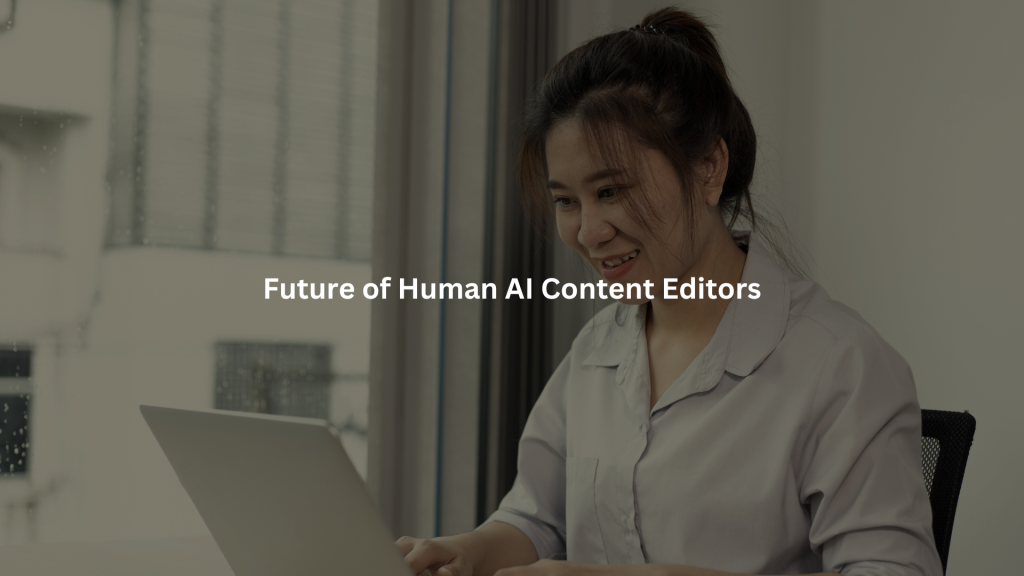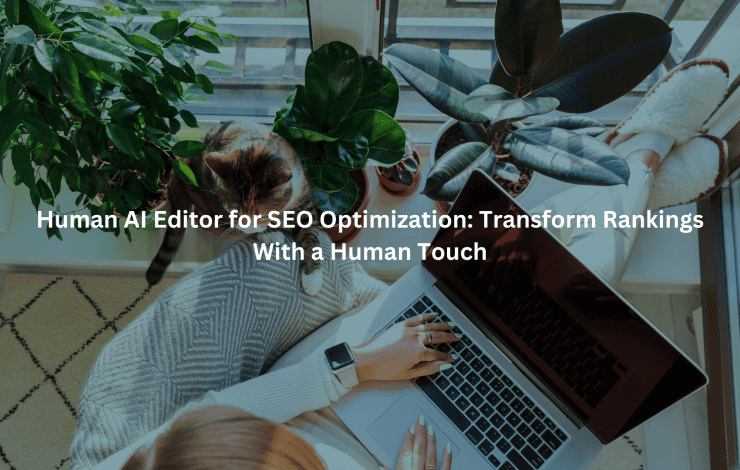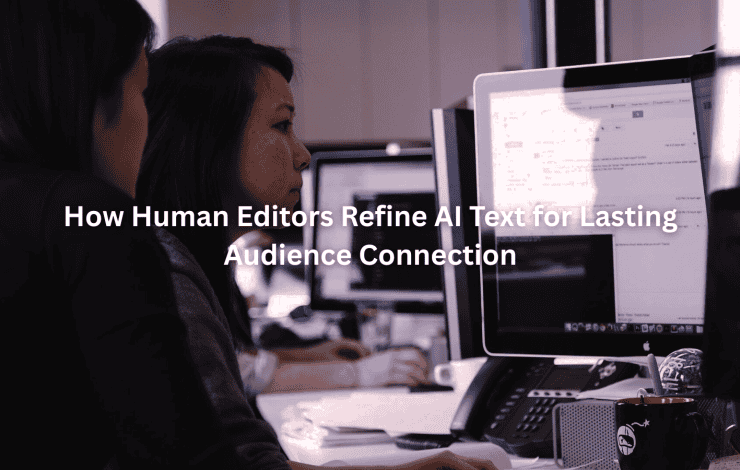Deadlines don’t wait, and writer’s block just makes things worse. An AI content editor, though, can really cut down the time it takes to get words on the page. It’s not magic, but it does help organize thoughts, catch mistakes, and push out cleaner drafts faster than most people probably expect.
Marketers, bloggers, business owners, they all might find themselves breathing a little easier. With the heavy lifting handled, there’s actually space to think about ideas instead of just scrambling to meet word counts. It’s not about replacing anyone, just making the whole process less of a grind.
Key Takeaway
- Speed up writing without losing your voice or clear meaning.
- Get editing done quicker with smart tips on grammar, tone, and how things flow.
- Let the tool handle the boring stuff so you can spend more time on real ideas.
Role & Value of Human AI Content Editors
It’s hard not to notice how much AI-generated content is out there now. Sure, it’s fast and sometimes gets the job done, but it’s obvious when a person hasn’t looked it over. There’s this gap, AI can hit the facts, but it just doesn’t nail the voice. That’s where human editors step in. They catch what the software misses. [1]
More Than Just Corrections
- Human editors don’t just fix typos or grammar.
- They look for relevance, context, and if the story actually makes sense.
- They notice when writing drifts off topic or loses its way.
Making Content Feel Real
AI can toss in keywords, but sometimes it reads like a checklist, not a conversation. Human editors smooth out the rough edges, making sure the writing sounds natural. Readers want something that feels genuine, not just SEO fluff. Editors add nuance, check the logic, and fill in missing facts. That’s especially true for technical or creative pieces, one odd sentence can throw off the whole thing or make it sound like a robot wrote it.
Beyond Algorithms
You can spot when editing is just by the numbers. Human eyes catch things algorithms miss, duplicate lines, weird keyword stuffing, or stale meta descriptions. Editors keep content fresh and accurate. They don’t just patch up AI drafts; they make them sound like a real person wrote them. That’s the difference that matters.
Human AI Editor for SEO Optimization
SEO isn’t just about cramming in keywords. Human editors who know their way around AI tools find the balance between ranking higher and actually keeping readers interested.
Smarter Keyword Use
- Editors run audits on AI drafts, looking for weird keyword repeats or forced phrases.
- They cut out the stuffing, use keyword mapping, and check what competitors are doing.
- The goal: keywords should fit naturally, not stick out.
Keeping Content Relevant
AI can spit out related keywords, but it doesn’t always get what matters in context. Human editors use briefs, outlines, and their own judgment to keep the structure tight and the topic clear. They write for both search engines and people, which is probably why their work brings in more organic traffic.
Strategy Over Shortcuts
Editors follow guidelines and use tools, but they don’t let those override common sense. They look for long-tail and contextual keywords that actually match what people are searching for. That’s where Jet Digital Pro seems to do well, they mix AI editing with real-world know-how. Editors double-check accuracy, make sure the keywords fit the topic, and always put the reader first. The results? Better performance, higher rankings, and way less risk of getting dinged for keyword stuffing.
Comparing AI Tools vs. Human AI Editors
AI tools are quick, no denying that. They can spit out a full article in just a few minutes. Anyone who’s tried them on big projects has probably seen drafts appear almost before you’re ready for them. But speed isn’t the whole story. [2]
- AI misses the little things. It doesn’t always catch cultural references or notice when a line just falls flat.
- Human editors step in for context. They fix awkward sentences, add real insights, and keep the tone steady from start to finish.
AI tools are usually cheaper, since most run on subscriptions. But that low price often means you get generic content. There’ve been times where whole blogs needed rewriting because the AI version sounded like it could’ve come from any site. Human editors do cost more, but what you get is original, creative, and actually interesting to read.
- Humans catch mistakes in structure and logic that AI tools just don’t see.
- AI is fine for grammar and spelling, but it can’t fix a story that doesn’t add up.
SEO is another spot where the difference shows. AI can throw out keyword ideas, but human editors know how to use those words without getting dinged by search engines. They understand how algorithms work and when to change up keywords for better results. Plus, they keep the author’s voice and make sure the writing fits the brand.
That’s why it’s not really a choice between the two. AI handles the rough draft, but humans do everything that actually counts.
How Human AI Content Editors Work
Our process is simple but thorough. First, we let AI do the heavy lifting, analyzing trends, generating content ideas, producing drafts. Then we jump in. We review the AI’s work, checking for alignment with the brand and the content strategy. Sometimes the draft is close. Sometimes it’s a mess. Either way, we get to editing.
We add our expertise. We tweak the content structure, add semantic search terms, and make sure the content outline supports the main message. We look at readability scores, fix awkward sentences, and add creative touches. We double-check facts, make sure there’s no duplicate content, and ensure the meta description matches the article. For on-page SEO, we check keyword integration, making sure it’s natural and effective.
The final step is refinement. We run the piece through AI writing tools for a last check, grammar, SEO analysis, and keyword suggestions. Then we give it one more human review. We make sure it’s ready for readers and ready for Google. At Jet Digital Pro, we follow an 11-step process. That means nothing gets published without a real human sign-off. We believe that’s the only way to guarantee both quality and search engine optimization.
Choosing & Hiring a Human AI Content Editor

Hiring a human AI content editor is about trust and results. We always look for editors who know both sides, how to edit and how AI-generated content works. Experience matters. We ask for a portfolio. We check if they’ve worked with SEO content editors, if they understand content guidelines, and if they’ve handled content audits or keyword clustering before.
We also look for people who can keep a consistent voice and maintain brand alignment. It’s not just about fixing typos. It’s about making sure the writing feels like it belongs to the client. Familiarity with editorial workflow is important. We want editors who are comfortable with AI tools but don’t rely on them completely.
We also check for technical skills. Are they up to date with search engine algorithms? Do they know how to map keywords, conduct competitor analysis, and write for semantic search? The best editors can do all of this. At Jet Digital Pro, we train our editors to handle both the technical and creative sides of content improvement. We make sure they can take a draft from AI and turn it into something worth reading.
Human AI Editor for Proofreading & Grammar
Proofreading is one spot where humans really stand out. AI can catch the obvious stuff, misspellings, missing commas, but it doesn’t always fix lines that just sound strange. There’s been more than one AI draft with perfect grammar but clunky phrasing. Readers pick up on that. Editors do too, and they fix it. They check for tense, voice, and style, making sure everything matches up.
- Human editors notice grammar issues AI skips, like subject-verb agreement, misplaced modifiers, or sentences that just don’t flow right.
- They follow style guides, but they’ll break the rules if it makes things clearer.
- They know when to use contractions or when to chop up a long sentence.
Editors also fix structure. AI sometimes puts ideas out of order or drops in a paragraph that doesn’t fit. Humans move things around, making sure each section leads smoothly to the next. They check if every part actually adds value. Proofreading isn’t flashy, but it’s what keeps writing sharp and readable. At Jet Digital Pro, editors spend extra time here. They think it’s worth it.
Integrating Human AI Editors into Workflow
Bringing human editors into the workflow is about finding the right mix. AI gets assigned to first drafts, data pulls, and basic keyword research. Humans step in for strategy, creativity, and the final polish. Collaborative platforms help pass drafts from AI to editor without too much hassle. It’s not perfect, but it gets the job done.
- Feedback loops matter. Editors leave notes for the AI team, flagging patterns or suggesting tweaks.
- Over time, AI tools improve, and editors adjust how they work.
- Everyone keeps clear roles, AI does the heavy lifting, humans do the finishing touches.
Communication keeps things moving. Teams meet weekly to check on progress and fix workflow snags. Content briefs and outlines guide the process, and SEO tools track how well things are working. If something’s off, it gets fixed. The goal: better visibility, more engagement, and steady organic traffic.
Challenges for Human Editors of AI Content
Editing AI content isn’t easy. The first problem is volume. AI can crank out more drafts than editors can handle in a day, which means bottlenecks. Teams manage by focusing on the most important content and grouping similar drafts together for quicker review.
- Quality control gets tricky when there’s just too much to go through.
- Editors use checklists, content audit, topic relevance, keyword use, accuracy, to keep standards up.
- Editorial workflows and feedback loops help catch issues before they get out of hand.
Staying up to speed is a constant job. AI tools change fast, so editors have to keep learning and adjust their process. Consistency is another headache, AI can drift in tone or voice, especially on big projects. Style guides and regular reviews help keep things steady.
At Jet Digital Pro, there’s a system in place. Editors get trained, tools stay updated, and the process gets checked all the time. It’s a lot of work, but it pays off.
Pricing & ROI for Human AI Content Editors
Cost Differences
Pricing for human AI content editors almost always runs higher than pure AI tools. Editors usually charge by the hour or project. AI tools, on the other hand, come as monthly or yearly subscriptions. Some agencies try to save money by going AI-only, but the trade-off is clear, content quality drops, engagement falls, rankings stall, and organic traffic slows down.
What You Get Back
ROI is just better with human editors. The content actually connects with readers. Numbers show higher engagement, smarter keyword use, and fewer problems with duplicate content. The brand’s voice doesn’t get lost in the shuffle. Clients can tell the difference. Over time, putting money into human editing pays off, better search visibility, more credibility, and that leads to more leads, more traffic, and more business.
How Jet Digital Pro Handles It
At Jet Digital Pro, the focus is always on ROI. They track everything, content performance, rankings, organic growth. The extra cost? It pays for itself. They’ve seen it happen.
Future of Human AI Content Editors

What’s Next
Are You a Digital Agency?
White Label SEO Content Services for Agencies
Scalable, customizable, and results-driven content solutions for your clients.
The future looks like a mix. AI will keep getting faster, maybe even smarter. It’ll take on more routine stuff, drafts, basic edits, keyword ideas. Human editors will move toward creativity, strategy, and quality control. They’ll run the workflow, keep an eye on guidelines, and make sure the brand’s voice doesn’t get lost.
Hybrid Teams on the Rise
More agencies and businesses will probably use a mix of both, AI for the heavy lifting, humans for the details that matter. Content strategy will get more technical, with a bigger focus on things like semantic search, keyword mapping, and regular audits. Editors will have to keep learning, always adapting.
Jet Digital Pro’s Approach
Jet Digital Pro is already set up for this. They blend AI speed with real human oversight. That’s how they make content that works for both readers and search engines.
FAQ
How can an AI content editor help identify and fix low-performing pages using keyword clustering?
An AI content editor analyzes your existing content for weak areas in keyword integration and topic relevance. It uses keyword clustering to find semantic keywords and related keywords that were missed during the original content creation.
By combining content audit data with SEO analysis, the tool improves content accuracy and search engine ranking through better keyword mapping, boosting organic traffic and search visibility.
What role does latent semantic indexing play in AI-powered editing and content optimization?
Latent semantic indexing helps AI content editors detect contextual keywords and keyword variations tied to user intent. It enhances semantic search by allowing the editor to refine keyword suggestions based on topic relevance rather than just keyword density.
This improves overall content quality, increases readability score, and ensures content aligns with search engine algorithms while reducing the risk of keyword stuffing or duplicate content.
How does an AI content editor support editorial workflow for consistent on-page SEO?
An AI content editor streamlines the editorial workflow by automatically generating content briefs, content outlines, and keyword research reports. These include insights on long-tail keywords, meta description suggestions, and keyword intent alignment.
By following clear content guidelines, editors can improve content structure, maintain content freshness, and ensure consistent keyword integration across all pages, boosting content engagement and on-page SEO outcomes.
Why is content readability just as important as keyword density in AI-generated content?
Need a Strategic SEO Content Partner?
Let’s craft SEO content that ranks, converts, and grows your brand.
Talk to UsWhile keyword density helps with search engine optimization, content readability ensures users actually stay and engage. An AI content editor balances these factors by analyzing readability score, sentence length, and content structure.
It suggests ways to enhance content performance without reducing SEO value. This balance improves user intent satisfaction, lowers bounce rates, and strengthens the connection between content relevance and organic traffic gains.
Can AI writing tools prevent keyword stuffing while still improving content enhancement?
Yes. AI writing tools use semantic keywords, keyword variations, and keyword mapping to boost content improvement without resorting to keyword stuffing.They measure keyword intent and analyze content engagement patterns to suggest natural language processing edits.
This ensures keyword integration feels organic. Combined with content audit data, the AI supports a smarter content strategy that follows search engine algorithms without over-optimizing.
Conclusion
Don’t rely on AI alone. Use it for speed, structure, and keyword coverage, but never skip the human touch. That’s how you get content that ranks and reads well.
We use AI for the heavy lifting, then run every piece through our 11-step human editing process. It works. Agencies trust us to deliver scalable, high-quality content that’s actually worth publishing.
Want SEO content that performs without the stress? Talk to JetDigitalPro.
References
- https://medium.com/@karama1976/the-role-of-human-editors-in-an-ai-driven-world-balancing-creativity-quality-and-ethics-92d98eca9f6e
- https://www.linkedin.com/pulse/ai-vs-human-video-editors-can-revolutionize-editing-industry-yj5fc#:~:text=While%20AI%20will%20continue%20to,that%20AI%20cannot%20easily%20replicate.
P.S – Whenever you’re ready,
we’re here to help elevate your SEO content.
Partner with us for strategic, scalable content that drives real organic growth.
Contact Us Now




